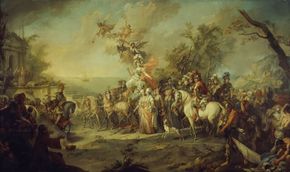Russo-Turkish War (1768–1774)
| Russo-Turkish War (1768–1774) | |||||||||
|---|---|---|---|---|---|---|---|---|---|
 Allegory of Catherine's Victory over the Turks (1772), by Stefano Torelli. |
|||||||||
|
|||||||||
| Belligerents | |||||||||
|
|||||||||
| Commanders and leaders | |||||||||
|
|
||||||||
|
|||||
|
|||||
The Russo-Turkish War of 1768–1774 was a decisive conflict that brought Southern Ukraine, Northern Caucasus, and Crimea within the orbit of the Russian Empire.
Contents |
Background
The war followed the internal tensions within Poland where there was the strife between the nobility and the king Stanislaus Augustus Poniatowski, a former favourite of the Russian Empress Catherine II. The king was dependent on Russian military backing.
A detachment of Cossacks in Russian service entered Balta (on Ottoman territory) during the pursuit of a Polish Bar Confederation force. The Ottoman Empire accused the troops of having conducted the slaughter of its subjects in the town of Balta, a charge denied by the Russian authorities.
War
Following this border incident at Balta, Sultan Mustafa III declared war on Russia on September 25, 1768. The Turks formed the alliance with the Polish opposition forces of the Bar Confederation, while Russia was supported by Great Britain, who offered naval advisers to the Imperial Russian Navy.
The Polish opposition was defeated by Aleksandr Suvorov. After that, he was transferred to the Turkish theatre of operations, where in 1773 and 1774 he won several minor and major battles for Russia following the previous successes of the Russian Field-Marshal Count Peter Rumiantsev at Larga and Kagul.
The naval operations of the Russian Baltic Fleet in the Mediterranean yielded even more spectacular victories under the command of Aleksey Grigoryevich Orlov. In 1771, Egypt and Syria rebelled against the Ottoman rule while the Russian fleet totally destroyed the Turkish Navy in the Battle of Chesma.
Despite their naval success, the Russians were unable to capture Constantinople due to the fortifications in the Dardanelles and the Bosphorus strengthened with the help of the French military adviser Baron de Tott.[1][1][2][3][4]
Peace treaty
On July 21, 1774, the Ottoman Empire signed the Treaty of Kuçuk Kainarji. According to the treaty, the Crimean Khanate formally gained its independence (but in reality became dependent on Russia), Russia received the war reparations of 4.5 million rubles and two key seaports allowing the direct access to the Black Sea.
This war was but a small part of the continuous process of expansion of the Russian Empire southwards and eastwards during the 18th and 19th centuries.
Notes
- ↑ 1.0 1.1 Imperialism and science: social impact and interaction by George Vlahakis p.92 [1]
- ↑ An Ottoman statesman in war and peace: Ahmed Resmi Efendi, 1700-1783 by Virginia H. Aksan p.116 [2]
- ↑ Armies of the Ottoman Turks 1300-1774 by David Nicolle p.21
- ↑ History of the Balkans: Eighteenth and nineteenth centuries by Barbara Jelavich p.117 [3]
|
|||||||||||